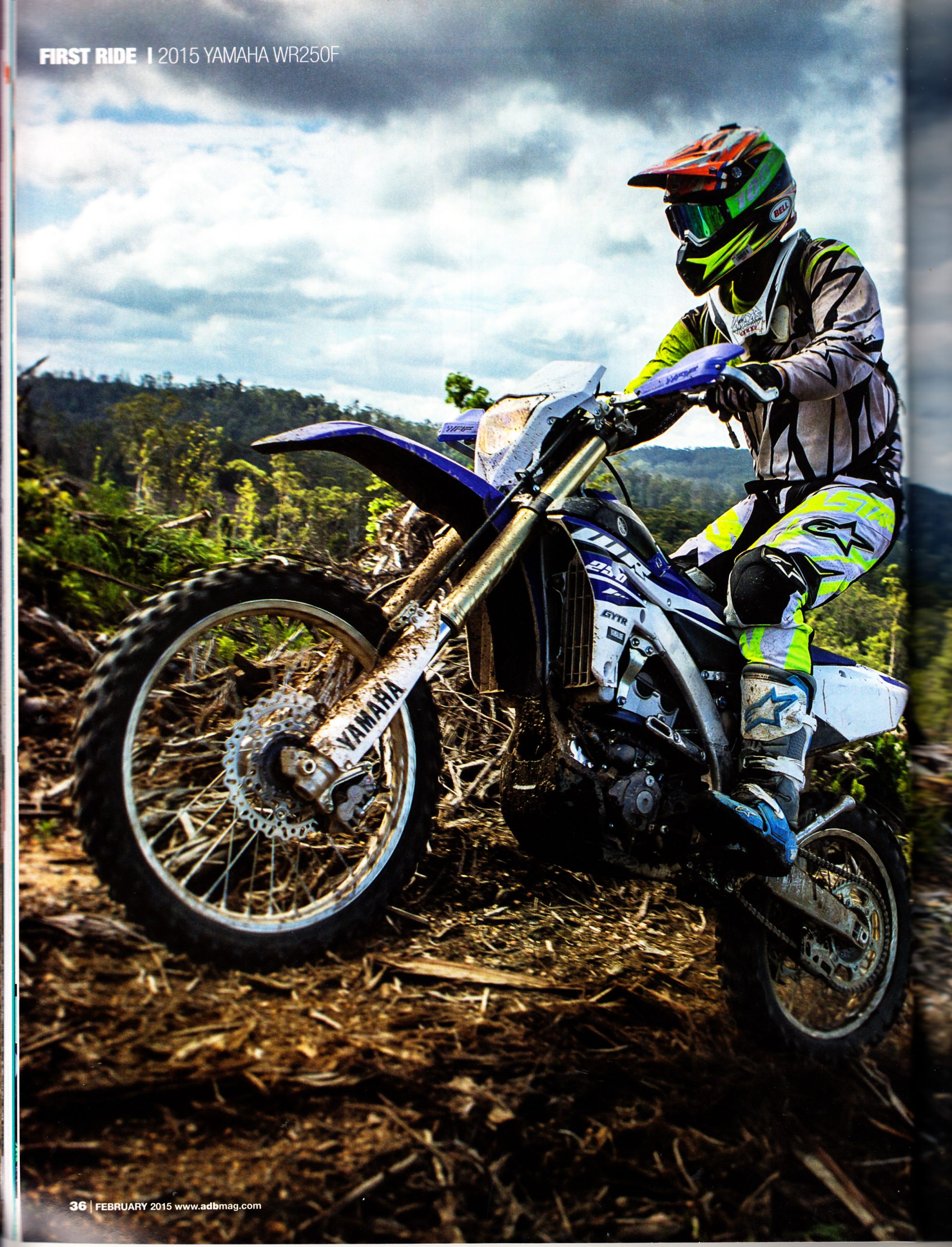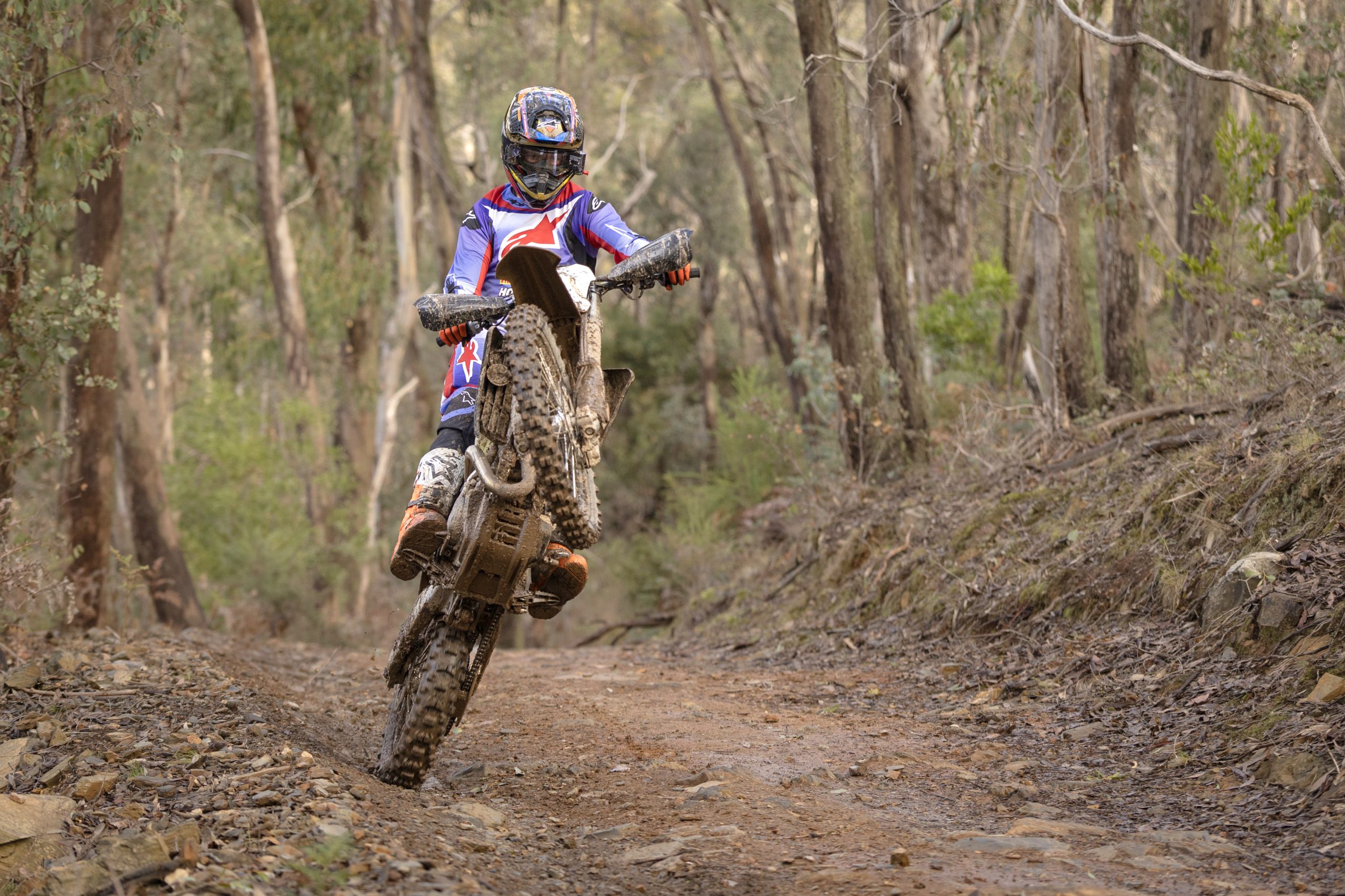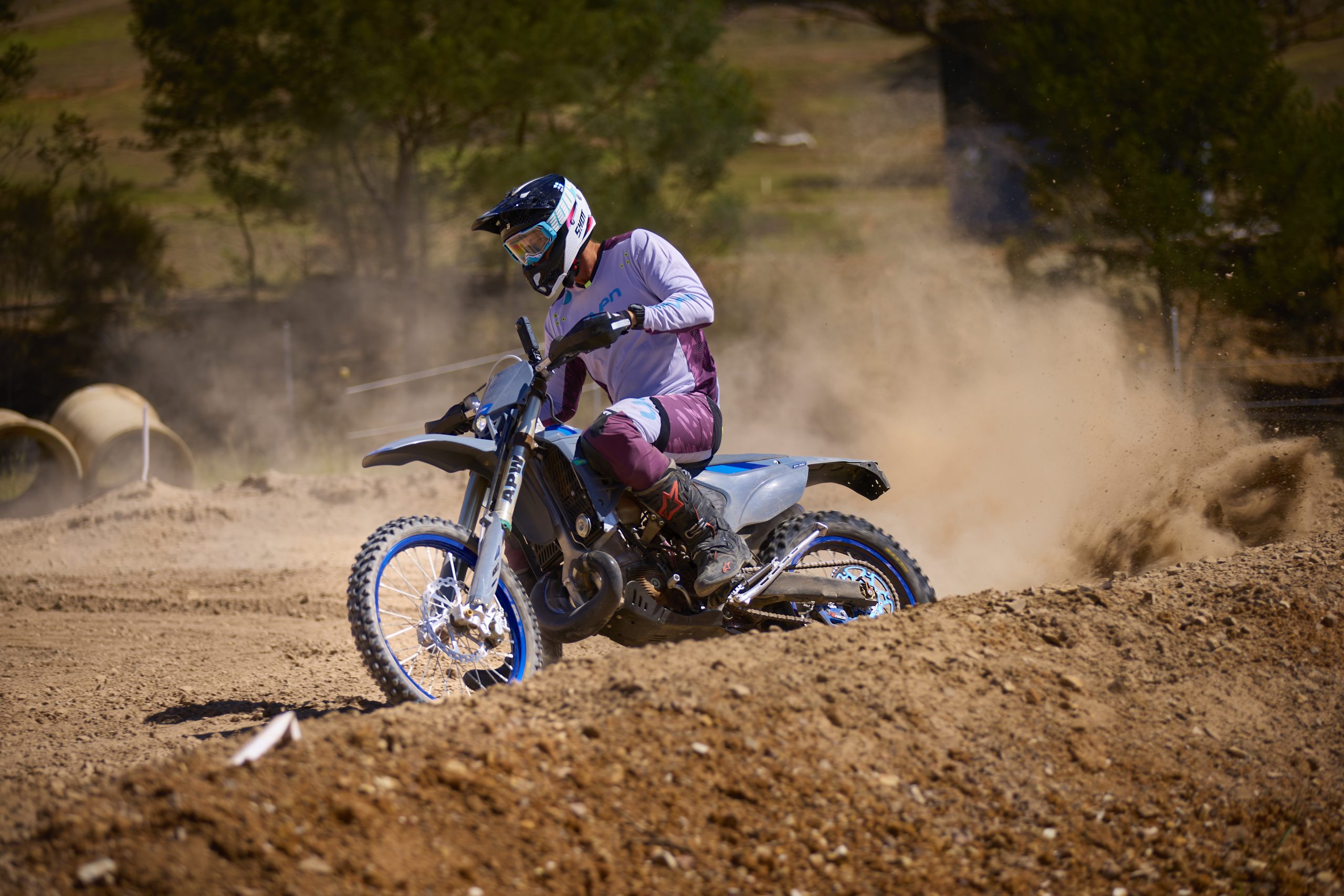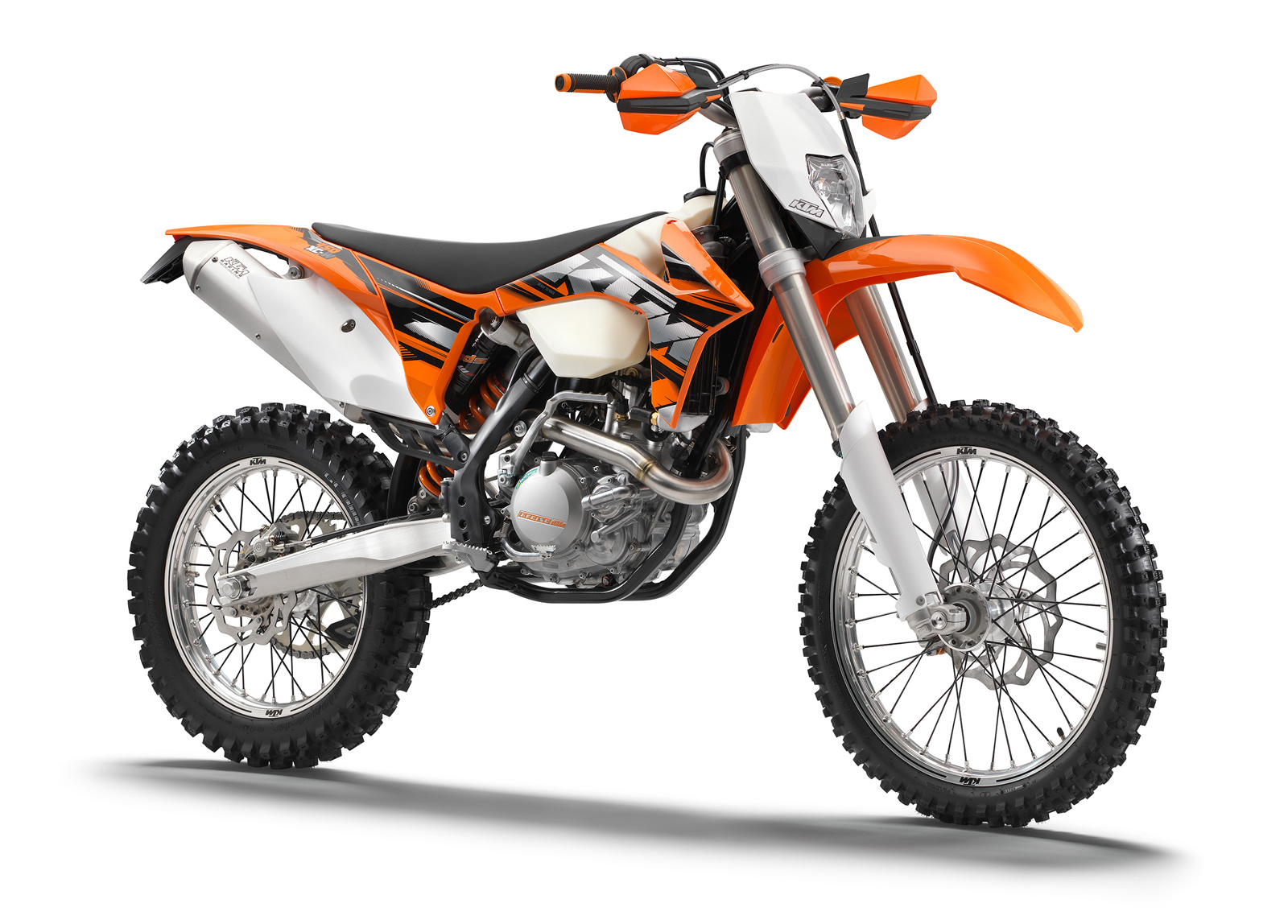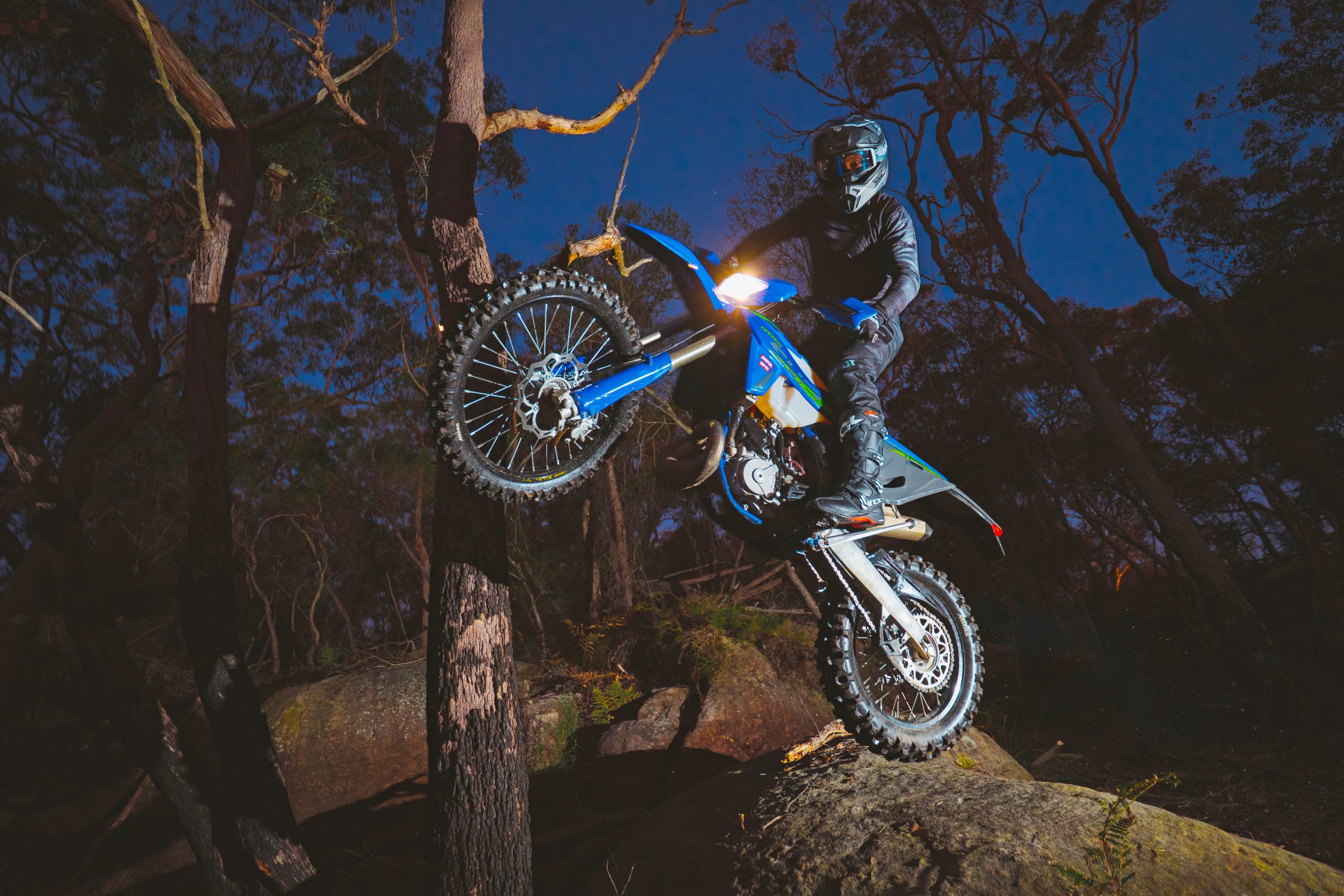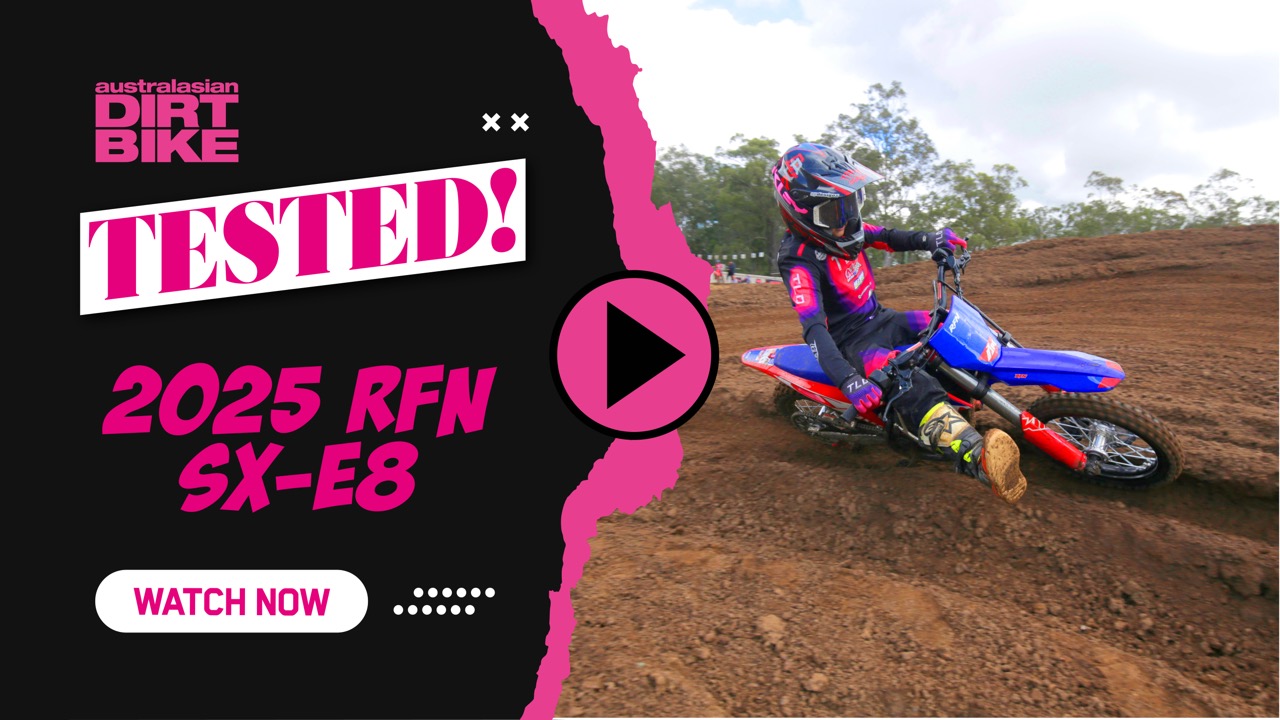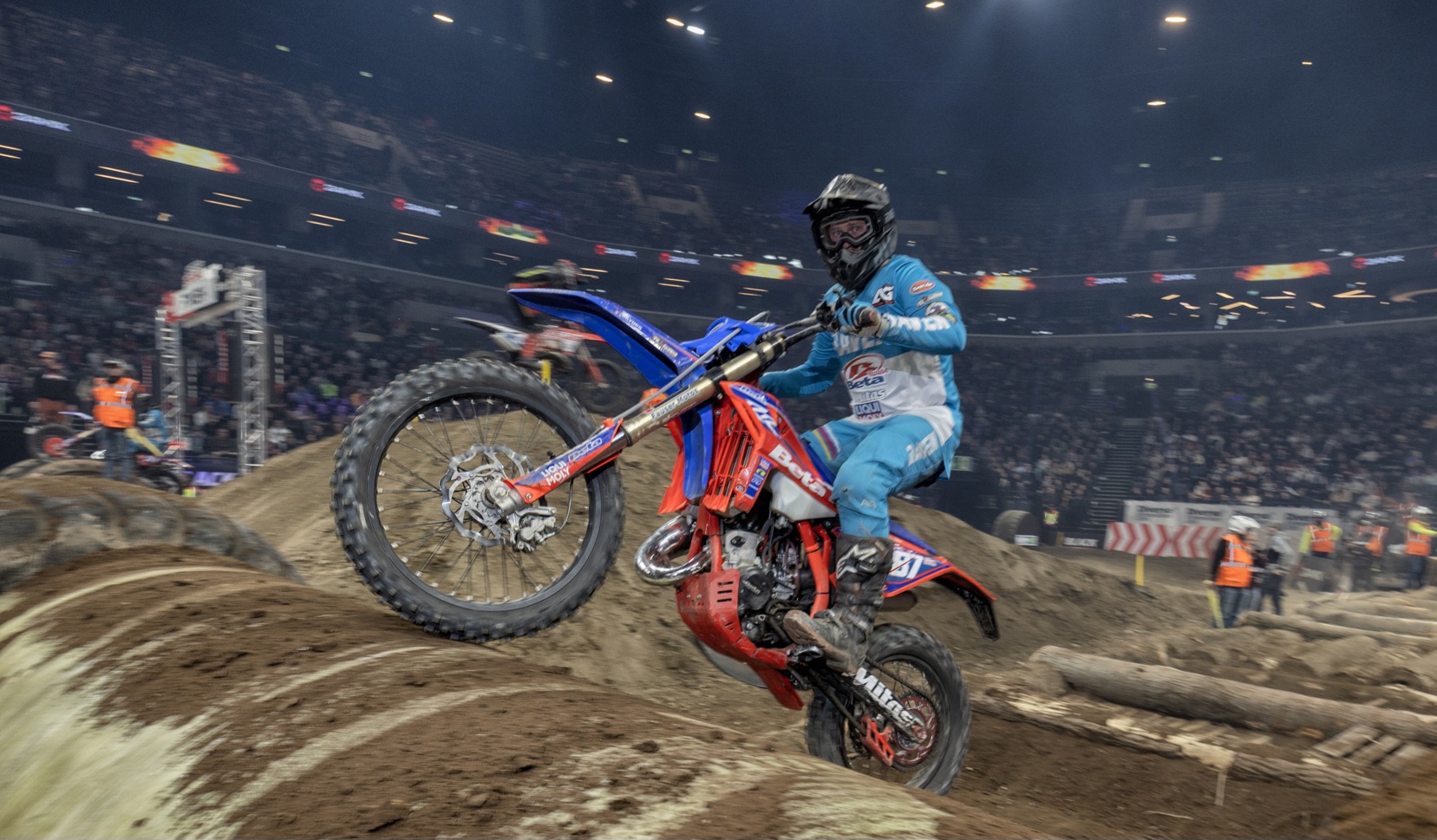The 300 two-stroke shootout put on by the ADB boys would have to be one of the best I’ve attended. Not because of the food and booze at the Taralga Hotel [which was great, by the way – Ed] but because of this year’s tracks and scoring format. In previous years, ADB’s 300 two-stroke shootout has been on one epic loop, usually singletrack.
But this year, with the aim of mixing it up a bit, ADB used a private property that featured a grasstrack, endurocross circuit and hard enduro loop. The three sections were scored separately and a winner chosen for each. ADB felt these three racing disciplines were the best way to showcase a 300 two-stroke’s abilities.
The property was near Taralga, NSW, and conditions were primo. Rain in the lead-up ensured the surface had traction, with the grasstrack circuit settling in perfectly during the day forming ruts, bumps and off-camber turns.
The endurocross track had a great blend of matrix logs, rock pits, log heaps, tyre jumps, balance beams and difficult corner obstacles. As for the hard-enduro loop, it started with a near-vertical drop into a creek which wound its way through water and over boulders before climbing nearly 300 metres out of a valley on sandy, steep string of singletrack.
It wasn’t over there though, dropping back into the creek on an off-camber goat track that saw a few riders cartwheeling bikes all the way down. It had pretty much everything you’d encounter on an awesome days trailriding on a 300 smoker where a 300 smoker should go!
HOW THEY’RE SCORED
For this 300 two-stroke shootout there will be three winners, one for each category: grasstrack, endurocross and extreme enduro. Each bike gets its own scorecard for each track and each scorecard is broken into three weighted sections: suspension and handling (50%), motor (40%) and ergos (10%). The scoring components in each scorecard are different to suit the criteria of that particular discipline.
The bike with the highest weighted average score from all the testers is the winner in the category. When scoring each bike, the tester is required to think like a 300cc two-stroke rider. Weighting the scores means personal things like ergos do not count for much of the total.
Husqvarna TE300i

I was excited about the prospect of riding the Husqvarna TE300i, but I was also a little hesitant. Back when a lot of the four-strokes were switching from carburettors to EFI, I was so excited to ride one, only to be massively disappointed as I felt the fuel-injected bikes were not as good as the carburettor models.
Fast forward to now and I was thinking this could be the case on the two-strokes that have switched. Husqvarna no longer has a carburettor version of its 300, the only option is the TE300i that features a transfer-port injection (TPI) system that’s only in its second year of production. I hadn’t really seen one of these EFI two-strokes, so it was definitely different seeing a 39mm throttle body sitting in the spot where I’d seen a carburettor my whole life.
My first two minutes on the 300i were not very impressive, it felt flat and didn’t impress me anywhere else in the rev range either. So I headed back to Christian, the Husqvarna honcho, to see if this was as good as it would get. Luckily it was not, as the Husqvarna comes with an engine map switch on the handlebar. A push of the button and I was back on the track with a lot more excitement underneath me.
Now the power was a lot stronger off the bottom and into the mid-range. Top-end felt a little less than what I would expect from a 300 two-stroke on a grasstrack. It wasn’t until I rode the endurocross and extreme tracks that I could feel how smooth and easy to use it was.
The WP Xplor 48 fork and monoshock work really well over a wide variety of terrain. They are not as soft as, say, the KTM but still very plush. With the biggest price tag of $15,295 in this bunch you would hope the Husky comes with lots of the fruit, and it does. Preload adjusters on the fork, quality Pro Taper handlebar, map switch and more. Husqvarna has done a great job at creating a bike that works for all levels of riders.
KTM 300 EXC TPI
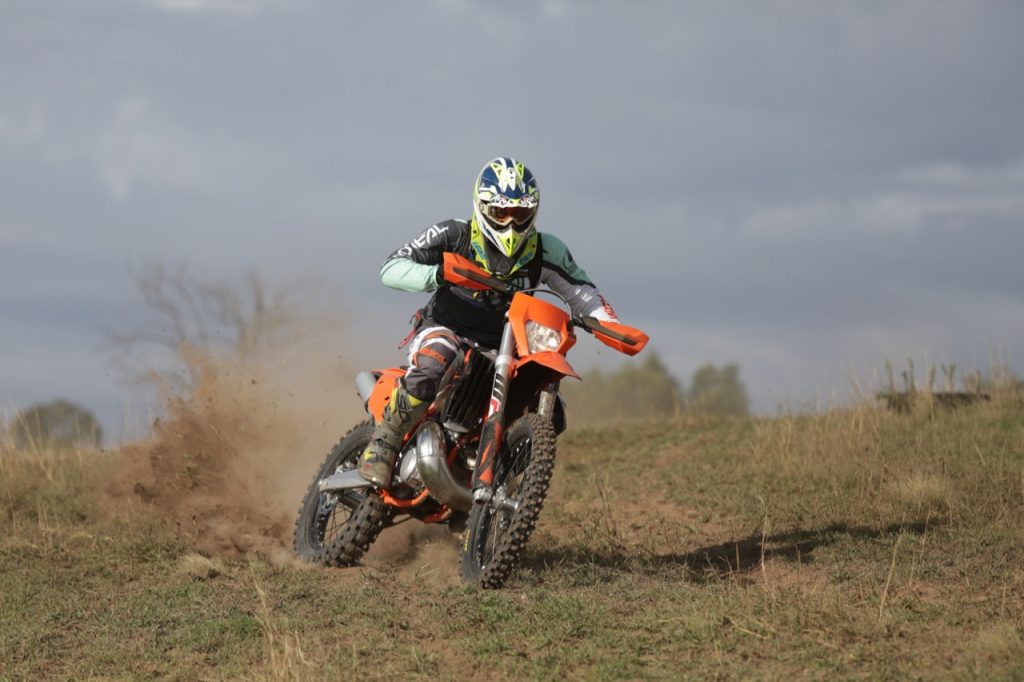
KTM is in the same boat as Husqvarna, with its new 300EXC TPI now being its only bike for this class. On the track, my first impressions were not that great, as it felt flat in bottom-end power, like the Husqvarna did at first. The issue with the Kato was that it doesn’t come standard with a map switch so I couldn’t crank it up.
Glenn Kearney was looking after the KTM and made some changes to the exhaust power valve, which did improve the bottom-to-mid range, but not to the level of the Husqvarna.
KTM was the only bike in this 300 two-stroke shootout with a non-linkage, PDS shock and that gives a very soft, forgiving, slightly active ride.
It’s also handy having no linkage to get snagged on big logs or extreme sections. I’m not overly tall so I did notice the taller seat height of 960mm, it’s up there with the Husqvarna and Gas Gas. The KTM has the smallest fuel tank at 9.0 litres but, with a claimed 2.87L/100km fuel consumption that shouldn’t be an issue. The KTM is at the high end of the prices here at $14,495 but it does have a lot of nice little features.
ODI Lock-On grips are kind on the hands but so simple to change, the non-clogging footpegs work very well in harsh conditions, and KTM’s air filter access and replacement system is arguably the simplest on the market and one of the easiest to access.
The Kato might not have all the bells and whistles of the Husqvarna, but is still one very versatile enduro machine.
The super-friendly nature of the TPI engine makes it a very capable bike in extreme conditions, while also offering a forgiving, friendly ride for your average Joe.
Sherco 300SE-R
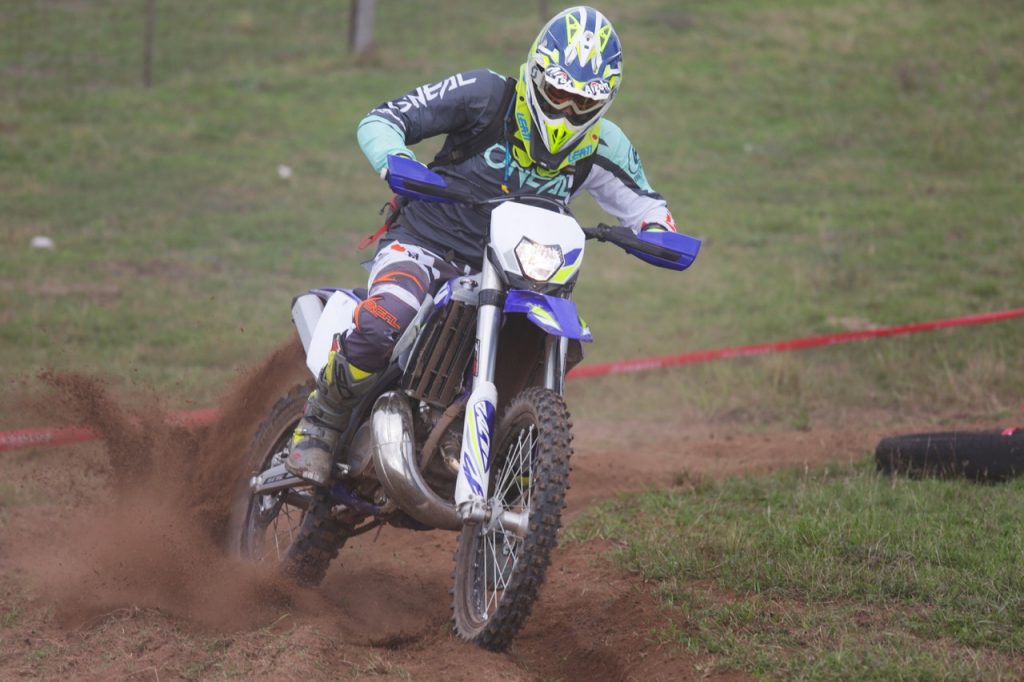
Sherco’s 300 two-stroke has been known as a bit of a monster in the engine department over the last few years. This has been addressed for 2019 with a new cylinder, tweaked exhaust power valve, new ignition management system and lightened ignition rotor to improve torque and deliver more linear power.
Did it tame the beast? Yes and no. On the track with the power map switch in Hard mode, it still makes class-leading horsepower but at a more controllable rate. It can still be intimidating if you grab a fist full of throttle but now it’s a lot more controlled.
This engine is also the only one here that has an electronically-controlled power valve and booster that also adds to the slightly unusual power. Easily my favourite feature of this bike was the map switch in Soft mode. It feels like it cuts the power in half, making it really manageable in extreme terrain, especially when tired.
New this year is the WP Xplor 48 fork matched to a WP monoshock. Both fork and shock are on the firm side, compared to the opposition and reward a faster rider, or someone above the 90kg mark. I’m only 84kg and it worked well for me on the grasstrack and extreme loop. The only time I felt it was a tad firm was on the endurocross section.
I was also impressed with front-wheel grip on off-camber corners, especially on the grasstrack. The slightly lower seat height of 950mm made it a little easier to get my feet on the ground in tricky situations. Trailriders will love the 10.4-litre fuel tank as it’s the biggest in this group. It also boasts the lowest price tag of $12,390, making it excellent value for money and a very appealing option.
Beta RR300
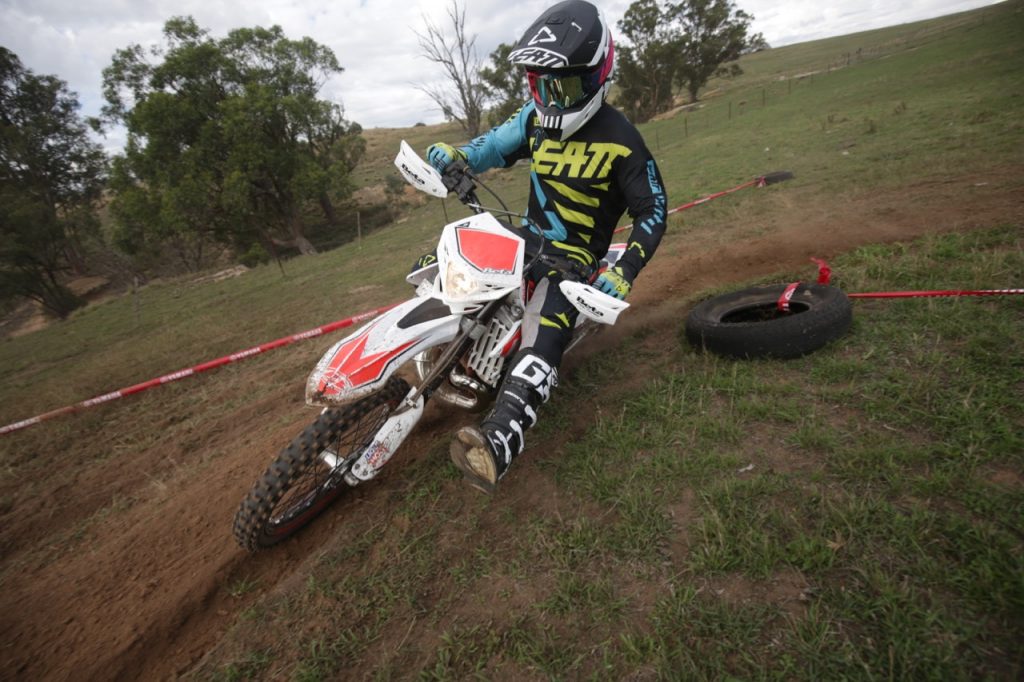
Only five dollars dearer than the cheapest offering in this class, the Beta RR300 has a very attractive price at $12,395. I have spent a decent amount of time riding the previous two models while I worked at Beta.
As I am a big fan of the RR300 I was keen to see how the new model felt. Hopping off any of the other bikes, the Beta’s seat height of 930mm is easily the lowest and you notice it straight away. It’s something I like as I’m not overly tall.
I found the engine very powerful with its new ECU and adjustable BPV exhaust valve. I actually found it too aggressive, so a quick stop at Beta guru Vic had him adjust the power valve to mellow out the power.
This was a fast fix and had me much happier with the delivery. I found the Rain mode option with the map switch was my preferred setting over all the tracks. Beta has gone with a ZF Sachs 48mm fork and redesigned ZF Sachs monoshock following a rebranding by that company. On the grasstrack I was happy with them but on the endurocross and extreme tracks I got a lot of harshness from both ends. In the past the Beta has been very surefooted in techo stuff, so it was a surprise to feel this wasn’t the case anymore. The other feature that makes this bike feel different from the rest, is the low seat and a tallish handlebar gives it a slight trials-bike feel and that’s not a surprise with Beta’s strong history in that discipline.
It’s still the perfect-sized bike for riders on the shorter side, with its strong engine that is easily tuneable via the power valve and map switch it’s definitely got a place in this competitive class.
Gas Gas EC300
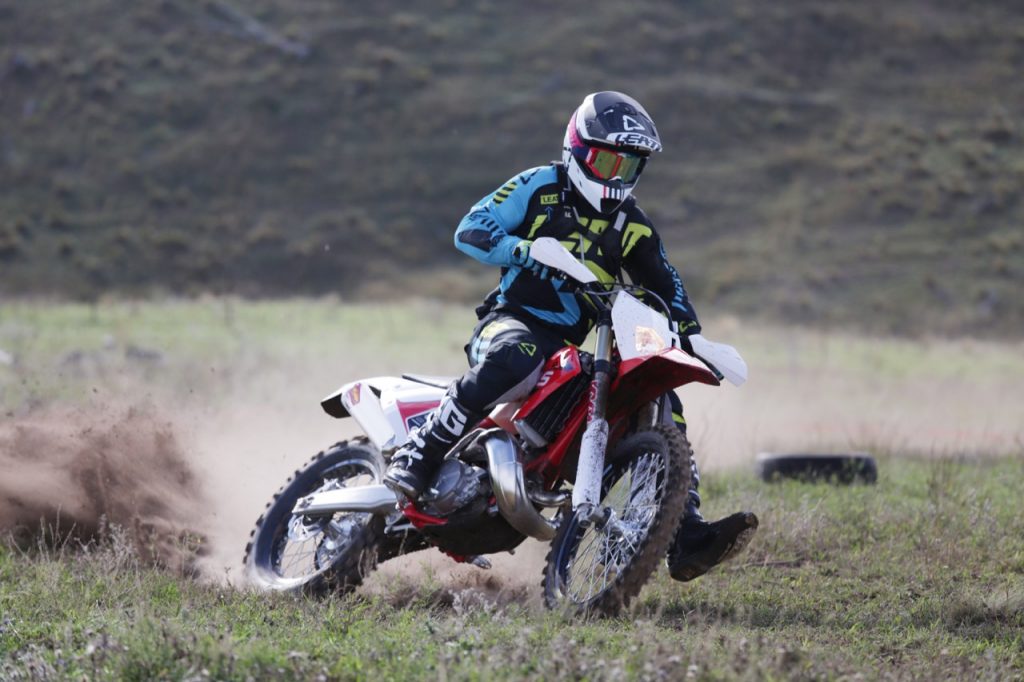
Gas Gas stormed back into the Australian market last year, winning the ADB 300 two-stroke shootout and taking top two-stroke honours in the Australian Off-Road Championship. And it looks like the Spaniards have decided to refine an already popular package.
As soon as I fired the EC300 into life I could tell the new electric-start system was faster and made quick getaways easy. The cockpit has improved with the new 28.6mm diameter handlebar and Neken handgrips.
On the track I found the engine the mellowest of the carburettor bikes. Also new is the Sun/Rain map switch and I did find a decent amount of difference between the maps, nothing like the Sherco but enough to make it a good option over varying terrain.
A redesigned cylinder head that increases thermodynamic performance has definitely kept this an easy engine to hang onto. The overall size feels very similar to the KTM and that’s no surprise as they share the same seat height of 960mm with the Husky.
The stand-out feature is easily the KYB 48mm closed-cartridge fork and monoshock.
This is the only bike in this group with a dual-chamber spring-cartridge fork and it helps big time when you ride the EC.
It doesn’t seem to matter what kind of terrain you throw at this suspension, it eats it up with ease.
Because of the quality suspension, this bike can keep a very wide variety of riders happy and, with the small improvements Gas Gas has made in the power, starting and ergos, it is a very appealing package, especially with a price of $12,490.
The winners of the 300 two-stroke shootout are…
No doubt about it, this is a tough market segment to compete in these days. All the bikes are worthy candidates, but there can only be one winner, or in this case three.
Grasstrack
After the scores were tallied up, the TE300i took top honours. The Husqvarna is such a well-rounded package and the EFI engine is easily the most usable 300cc two-stroke on the market. The Sherco was a very close second thanks to its racey feel and grasstrack setup. Its engine was crisp and its cornering ability on the off-camber terrain exceptional.
Endurocross
Endurocross top honours went to the Gas Gas EC300. Pretty much all test riders scored it top in the suspension department, so it’s no surprise to see it win on an obstacle-strewn track. The Husqvarna was nipping at its heels with the best engine score in the group for the endurocross track.
Extreme Enduro
Top honours went to the Husqvarna with good scores in both engine and suspension, followed by the EXC which, not surprisingly, had similar scores in engine and suspension.
300 Two-Stroke Shootout Verdict…
Interestingly, the Husqvarna and Gas Gas made the top three in all three disciplines. Sherco proved it has one of the best setups for racing grasstrack and the Beta performed best in the extreme enduro format. It is crucial to consider price when making your decision, so in case you missed it: Sherco – $12,390, Beta – $12,395, Gas Gas – $12,490, KTM – $14,495, Husky – $15,295.
On-Going Costs
Husqvarna
Top-end kit:
Piston & Rings $250.31
Circlips comes with piston
Gudgeon Pin comes with piston
Little End Bearing $20.90
Top End Gasket Kit $76.81
Total $348.02
Service intervals
Piston change 40 hours
Minor engine service 10 hours
KTM
Top-end kit:
Piston & Rings $250.31
Circlips comes with piston
Gudgeon Pin comes with piston
Little End Bearing $20.90
Top End Gasket Kit $76.81
Total $348.02
Service intervals
Piston change 40 hours
Minor engine service 10 hours
Sherco
Top-end kit:
Little end bearing $39.29
Clips $1.50
Pin $49.52
Piston and rings $207.90
Base Gasket $20.90
Head O’Ring $22.15
Head O’Ring $3.71
Total $344.97
Service intervals
Piston change 40 hours
Minor engine service 10 hours
Beta
Top-end kit:
Piston kit inc rings & gudgeon pin/clips
Little end bearing
6 x head bolt washers
Inner and outer head o-rings
L&R P/V gaskets
Base gasket
Total $343.75
Service intervals
Piston change 60 hours
Minor engine service 10 hours
Gas Gas
Top-end kit:
Piston
Gaskets
Print kit
Little end bearing
Total $320
Service intervals
Piston change 70hrs – inspect (through exhaust port)
100hrs – not recommended to exceed even if wear looks ok
Minor engine service 10 hours
THIS FEATURE WAS FIRST PUBLISHED IN ADB ISSUE #477 – JUNE 2019 – WORDS: BEN GRABHAM, PHOTOS: MITCH LEES
